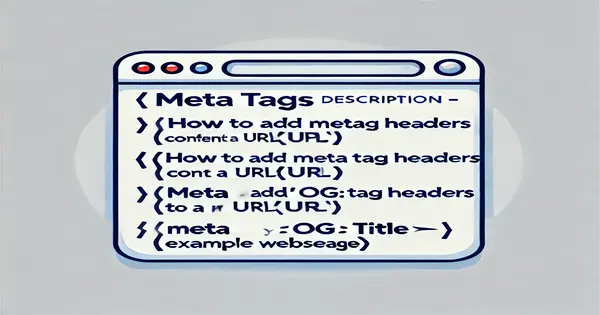How to Add Meta Tag Headers to a URL: A Complete Guide
Meta tags play a crucial role in defining how a webpage appears in search results and social media platforms. They help search engines understand your website’s content and improve your site's visibility. If you are looking for a step-by-step guide on how to add meta tag headers to a URL, this article will provide you with a clear and concise explanation.

What Are Meta Tag Headers?
Meta tag headers are HTML elements that provide metadata about a webpage. They are placed within the
section of an HTML document and influence how search engines and social platforms interpret and display your site. Some of the most commonly used meta tags include:- Title Tag (<title>Your Page Title</title>) – Defines the title that appears on search engine result pages.
- Meta Description (<meta name="description" content="A brief summary of your page">) – Provides a short summary of the page for search engines.
- Meta Keywords (although not commonly used anymore) – Specifies relevant keywords related to the content.
- Viewport Meta Tag (<meta name="viewport" content="width=device-width, initial-scale=1.0">) – Helps in making websites mobile-responsive.
- Open Graph Tags – Used for social media previews, such as when sharing on Facebook or Twitter.
Step-by-Step Guide to Adding Meta Tag Headers to a URL
This concise guide provides a clear, 5 steps process for adding meta tag headers to any URL, empowering you to improve your site's SEO and attract more organic traffic by focusing on the crucial role of meta tags in website visibility and search engine ranking.
Step 1: Open Your HTML File
To add meta tags, you first need access to the HTML file of the webpage where you want to insert them. The file is usually named index.html or something similar.
Step 2: Locate the Section
The <head> section of an HTML document is where all meta tag headers are placed. It appears before the <body> tag and contains important information about the webpage.
Example of a basic HTML structure:
<!DOCTYPE html>
<html lang="en">
<head>
<meta charset="UTF-8">
<meta name="viewport" content="width=device-width, initial-scale=1.0">
<title>My Webpage<title>
</head>
<body>
<h1>Welcome to My Webpage</h1>
</body>
</html>
Step 3: Insert Meta Tags
Now, let’s add different meta tag headers inside the <head> section.
Example 1: Adding a Meta Description
<meta name="description" content="Description will be here...">
This tag helps search engines understand the content of your webpage.
Example 2: Adding Open Graph Tags for Social Media
<meta property="og:title" content="My Webpage">
<meta property="og:description" content="Description will be here...">
<meta property="og:image" content="https://example.com/image.jpg">
<meta property="og:url" content="https://example.com">
These ensure that your webpage appears correctly when shared on platforms like Facebook and Twitter.
Example 3: Adding a Canonical Tag
<link rel="canonical" href="https://example.com">
Canonical tags tell search engines which page is the original, preventing duplicate content issues.
Step 4: Save and Upload the HTML File
Once you have added the necessary meta tags, save the HTML file and upload it to your web server. This ensures that the changes take effect and your meta tags are recognized by search engines and social media platforms.
Step 5: Test Your Meta Tags
It’s important to test your meta tags to ensure they are working properly. You can use the following tools:
- Google Rich Results Test (https://search.google.com/test/rich-results) – Checks structured data and meta tags for SEO.
- Facebook Sharing Debugger (https://developers.facebook.com/tools/debug/) – Previews how your page appears when shared on Facebook.
- Twitter Card Validator (https://cards-dev.twitter.com/validator) – Checks how your webpage will be displayed on Twitter.
Adding meta tag headers to a URL is a simple yet powerful technique to improve your website’s visibility and user engagement. By following the steps outlined in this guide, you can ensure that your webpage is optimized for search engines and social media platforms. Whether you are a beginner or an experienced developer, understanding how to use meta tags effectively will help your website perform better in search results and attract more visitors.
The Unexpected Benefits of...
Bookmarking Sites and Classified Site Submission: Boost SEO & Visibility
Boost your SEO and drive organic traffic with bookmarking and classified submissions Sites. Learn proven strategies, best practices, and avoid common pitfalls for online visibility.
How AI Tools are Transforming SEO: Strategies & Future Trends
Explore the transformative impact of AI tools on SEO. From content optimization to technical analysis, see how AI is reshaping digital strategies and what the future holds for.
Site Analysis Online: A Must-Know for Website Success
Perform comprehensive Site Analysis Online. Identify website weaknesses, improve SEO, and boost performance with our easy-to-use tools.
| Random Directories | URL | Type |
|---|---|---|
| WLD Directory | http://www.wlddirectory.com/ | Paid & Free |
| Add Page | http://www.add-page.com/ | Free |
| Canada Web Dir | https://www.canadawebdir.com/ | Paid & Free |
| Just Link | https://www.justlink.org/ | Instant |
| Your Articles | https://yourarticles.co.uk/ | Article |
